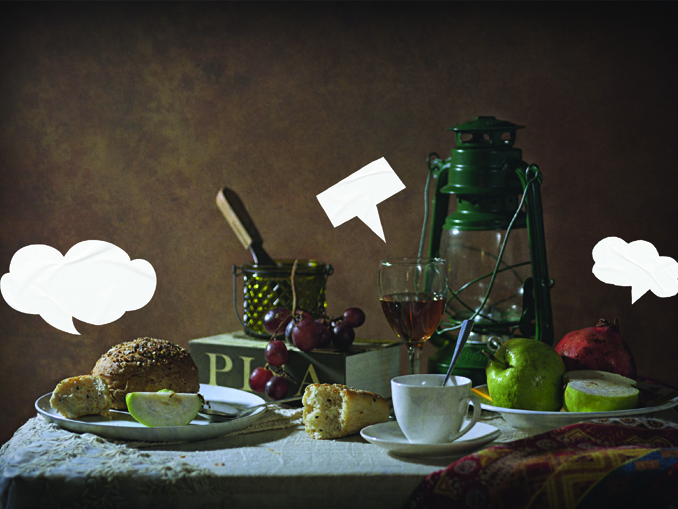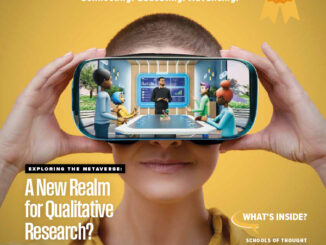
By Sónia Marques, Semiotician, Indiz, Lisbon, Portugal, sm@indiz.pt
Market research typically perceives every customer as a decision-maker, an autonomous entity seeking to fulfill personal preferences. Qualitative research, in turn, often regards consumers as expressive individuals whose voices must be heard and who must be placed at the forefront of research methodology. Within this individualistic framework of consumption, products are viewed merely as choices made by consumers. Could we stop for a moment and question this way of thinking? Is it possible to extract people from context and give attention only to consumer talk?
As researchers, we can listen to another set of voices. Everyday objects such as tables, books, sweaters, and glasses play active roles in shaping people’s experiences and interactions. Both people and objects actively “do,” and together, they “co-do.” By shifting the emphasis away from verbal communications to deep observation of “co-doing” actions, researchers can challenge traditional perspectives within disciplines like marketing and psychology and gain a higher level of holistic insight into human behavior.
The Value of Object-Centric Research Perspectives
From an anthropological standpoint, people undergo acculturation through their access to goods. Their identity as a woman, a student, an American, a Brazilian, a doctor, and so on is shaped by the objects associated with these roles. Toys are excellent examples of objects that acculturate children to their future social roles. Giving a doll or a chemistry kit to a girl or giving a plastic gun or a doll to a boy can mold their expectations. In essence, a cultural lens reveals that objects act as creators of people. The relationships between individuals and objects, as well as the connections between objects themselves, facilitate socialization, thereby molding individuals.

Contrary to the common practice of placing people at the center of decisions, a semiotician or anthropologist adopts a different approach, focusing on lifestyles instead of customer segments. Rather than envisioning people, they consider lifestyles as constellations of goods. This perspective stems from the understanding that a lifestyle comprises a set of goods exhibiting coherence, providing cultural consistency. By examining different lifestyles, these professionals unveil the intricate connections between goods, offering valuable insights into the cultural fabric of society. Lifestyles are not expressions of individual choices; they are constellations of goods that provide cultural consistency.
The acceptance of lifestyles as configurations of goods may encounter resistance from those who have a bias against material possessions and the societal emphasis on personal attributes. Frequently, individuals who express a fondness for possessions and maintain an abundance of items in their homes are unfairly stigmatized as “materialistic.”
Objects Are Agents
|
Put Objects on Stage and Give Them a Microphone
It is essential to recognize the inherent vitality of objects and acknowledge their role as active participants rather than passive elements in the background of our lives. “Objects” shouldn’t remain silent, and as researchers, we can bring them to the foreground. The conventional perspective that confines thought solely to the brain overlooks the fundamental aspect that our experiences are inherently embodied and situated; objects are part of this experience.
To gain a more profound insight into human behavior, it is imperative for researchers to understand the language of objects and examine how people interact with them. The query arises: Doesn’t prioritizing actions inherently place people at the center? The answer is no, and for the following reasons:
- Objects, such as tables, cars, and bottles, are not passive elements in our lives; rather, they actively shape our experiences and interactions. Thus, it is crucial to center the study of human behavior on both people and things.
- Objects operate as mediators in human interactions on a subtle, often unconscious level. Artifacts convey unspoken messages, inscribe unwritten narratives, and articulate aspects of social practice that may elude verbal expression. Material culture, precisely due to its inconspicuous nature, has the potential to communicate more efficiently than language.
- Many embodied experiences, like sitting at a table or riding a bike, elude verbal articulation. People engage in these activities without necessarily being able to rationally verbalize their actions. This “practical awareness” is best understood through observing activities rather than relying on verbal explanations. Consequently, researchers should analyze what individuals are doing at the table, for instance, rather than solely relying on what they say about their actions. Questions about furniture and spaces may not yield valuable insights, as the specificity and situated meanings are best explored through careful observation.
In essence, giving prominence to actions does not equate to placing people at the center exclusively. Both people and things coalesce as active agents. Researchers must acknowledge the agency of both entities. Objects co-do; they’re agents. Understanding implies giving agency to things and perceiving the body as a form of cognition.
Taking a cultural approach, which combines anthropology and semiotics, can challenge traditional dualisms—such as the distinctions between person and context, mind and body, and mind and reality. To delve into a greater comprehension of human behavior, researchers must adeptly converse in the language of objects and closely observe how individuals interact with various products.
The pandemic provided an opportunity to examine how important context is when studying the language of objects. During the spring of 2020, Olivia Harris photographed how Londoners experienced their first lockdown. The result, her photo series “Days on Repeat,” is a fascinating piece of work. The objects in the photos, dislocated and “mismatched,” show how life during the pandemic went awry, and everything that was socially established changed. A laptop in a laundry basket. Musical instruments on a roof. People blowing out birthday cake candles with their fingers, working in a bikini, socializing next to garbage cans, or having brunch in a parking space. Harris’s images captured these moments before the availability of vaccines put many objects back in their expected context.
www.olivia-harris.co.uk/days-on-repeat/about
Thinking with the Body
Traditionally, thought has been closely linked with the mind, with the common perception that thinking occurs within the brain and ideas originate from individuals’ heads. This prevailing view, often referred to as an “internalist” perspective, is widely accepted in philosophy and contemporary psychology. Despite its intuitive and seemingly logical nature, this perspective poses challenges when attempting to comprehend the intricate relationship between individuals and objects.
In essence, this internalist viewpoint tends to limit the exploration of the connection between people and their surrounding environment. While neuroscience and measurements of brain activity provide precision, relying solely on these data may prove inadequate for a comprehensive understanding of reality. The emphasis on internal processes may overlook the dynamic interplay between individuals and the external world.
Recognizing the agency of objects allows for a richer understanding of the intricate relationships between people and their material surroundings. Objects are not mere props; they are dynamic participants, influencing and co-shaping the experiences of those who engage with them.
A cultural approach treats situations as a mixed zone of physical involvement: an area where the brain, the body, and objects like tables and chairs converge. This approach avoids isolating individuals from their context, recognizing the interconnectedness of people with their surroundings, such as customers with tables and sociability with drinks.
Designing Object-Centric Methodologies
To impart agency to objects in qualitative studies, the methodology should be situational, observation-based, and include contrasting elements. Take the example of a table; the approach involves observing at least two distinct tables in different settings. This observation should be meticulous, structured, and documented through detailed observation sheets. The field of environmental psychology provides guidelines for this type of qualitative research and sets the minimum number of observational sheets at 250, but some samples may require as many as 500 sheets in order to capture the appropriate amount of detail. In the case of a table, various scenarios should be explored, including breakfasts, lunches, drinks, and dinners, covering formal and informal situations, and large and solitary groups. The observation sheets should capture intricate details such as changes in body posture every five minutes over a quarter of an hour, the placement of feet, the inclination of the back, the number and nature of conversations, the volume of voices, positions of arms and hands, ways of packing personal objects, directions of gazes, toasting gestures, seating and leaning preferences, serving dynamics, and drinking habits on the furniture.
In this context, tables are considered agents with a multifaceted role. They congregate and unite, serve, accommodate, share, and possess the ability to shape or abolish hierarchies. Recognizing the nuanced influence of tables, and by extension, objects in general, allows researchers to unveil the intricate ways in which these elements mold and contribute to the dynamics of a given situation.
This comprehensive method aims to offer a nuanced understanding of how individuals interact with objects, enriching the qualitative analysis of human behavior in various situations.
Implications of Object “Fluency”
In 2024, only a few brands are skilled at speaking this “language of objects.” Currently, most businesses ardently focus on branding, endeavoring to imbue products with meaning beyond their utilitarian functions. This strategic approach aims to elevate the status of the products they sell, ensuring they transcend the label of mere “commodities.” Consequently, companies invest considerable effort in shaping the narrative around their products to convey a deeper significance. However, this fear of commodification can create a bias, and as a result, the products themselves are often not perceived as valuable or differentiated.
Given the emphasis on branding as the status quo, it’s hard to imagine a bigger advantage for companies that fluently communicate in a language their competitors don’t understand.
Understanding objects means focusing on what companies can change. Our clients can only adjust their products and their surroundings, not people. So, studying how objects affect situations and seeing how they combine with other factors to shape experiences means dealing with manageable aspects. Tables, glasses, bottles, and even the surroundings of a coffee cup in ads can all be altered. Offices, stores, ads, packaging—speaking the language of objects revolves around what can be adjusted.
This article emphasizes the crucial role of objects in shaping human behavior, rituals, and experiences and questioning prevailing notions that tend to prioritize individual decision-making. It urges researchers to decenter the understanding of subjectivity. For market researchers, comprehending how people interact with objects offers access to deeper observations, tapping into tacit knowledge that consumers usually struggle to articulate, and providing insights into consumer rituals.
References
Miller, Daniel, The Comfort of Things, 2009. Polity, UK.
Malafouris, Lambros, How Things Shape the Mind, 2016. The MIT Press, Cambridge, Massachusetts.
Tilley, Chris, et al., Handbook of Material Culture, 2006. Sage Publications Ltd., London, UK.
Csikszentmihalyi, Mihaly, Rochberg-Halton, Eugene, The Meaning of Things, 1981. Cambridge University Press.





